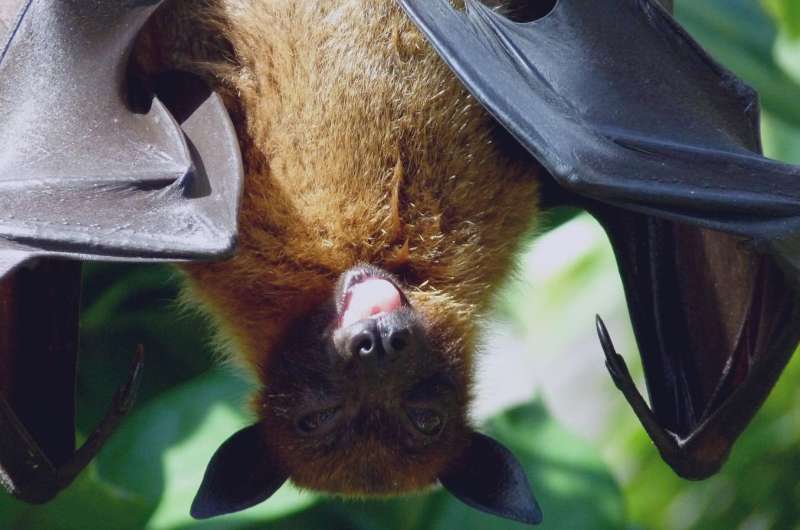Credit: CC0 Public Domain
The novel coronavirus isn't the first virus to jump from animals to people and wreak havoc.
HIV. Ebola. Swine flu. Bird flu. SARS. MERS.
The list goes on, and it's going to grow longer.
In an essay published Thursday in the journal Science, an international team led by San Diego Zoo Global researchers calls for scientists and wildlife experts to routinely test animals for viruses in open-air markets that sell fresh meat, fish and produce (wet markets), wildlife farms and other potential disease hot spots.
The genetic sequences of these viruses would be added to a common database for scientists to monitor and learn from. The idea is to go from simply reacting to outbreaks to anticipating them, and to shift from centralized monitoring efforts to local surveillance on a global scale.
"Human interactions with wildlife are fundamental to the public's health," said San Diego Zoo Global conservation geneticist Mrinalini Watsa. "The aim of the (article) was to reduce the risk of future pandemics by raising awareness internationally of the need and opportunity for modern wildlife disease surveillance approaches."
COVID-19, which has infected more than 12 million and killed more than a half-million people worldwide, has underscored the value of such approaches. And a report earlier this week from the United Nations said experts expect to see a steady stream of these diseases jumping from animals to humans in the years ahead as habitats are ravaged by wildlife exploitation, unsustainable farming practices and climate change.
Test Early, Test Often
To test wildlife for a virus, researchers often rely on certified laboratories. But about 60% of these labs are in Europe and North America, far from where most new infectious diseases appear. That's not ideal, says Watsa, the article's lead author.
"How do you get a sample across the Andes Mountains when you need to freeze it?" Watsa said. "Just making your lab closer to where you sample solves a lot of those problems."
Researchers say that local public health and wildlife experts should routinely test wildlife in their own communities. They advocate focusing on sites where different species come into close contact with people and one another, such as wildlife farms and wet markets, which also exist in the United States.
Monitoring the wildlife trade would be a better approach than attempting to ban it outright, the authors argue. Banning likely wouldn't work and would simply drive wildlife markets underground, making them harder to keep tabs on.
Understanding what viruses animals have (and at what levels) could help scientists know what's normal and what's not. Any change from that norm—such as viral mutations or an increase in a virus's abundance—could be a red flag.
Broad testing wasn't as feasible back in 2009, after the swine flu pandemic. But since then, sequencing technology has gotten smaller and cheaper. One sequencing device, the MinION, is about the size of a USB flash drive and hooks up to a laptop.
Portable sequencers have already been used to detect Zika, Ebola and, now, the novel coronavirus. But the authors say these tools are not yet being routinely used to monitor wildlife viruses.
"There are a lot of opportunities already to start collecting these samples. It's just having the right tools in the right hands to take that next step," said Caroline Moore, a pathology fellow at San Diego Zoo Global.
Valuable Data
This wouldn't be the first effort to find the next big infectious disease before it happens.
That was the goal of the United States Agency for International Development's appropriately named PREDICT program. PREDICT tested 168,000 animals in 30 countries and found 1,100 different viruses, but it was defunded by the federal government in 2019.
That has made University of California, San Diego researcher Matt Daugherty, who studies the evolutionary arms race between viruses and their hosts, more receptive to the decentralized approach proposed by San Diego Zoo Global researchers.
"Six months or a year ago, I might not have said that we should decentralize it," Daugherty said. "But the political situation has very clearly shown that if you put too much emphasis into one place, that one place can basically get the legs cut out from underneath it."
The tricky part, he says, is knowing what to do with the information from these studies.
"We've found tons of viruses that are a step or two away from breaking out in the human population," Daugherty said. "We can't design therapeutics preemptively to all of them."
Still, close monitoring could help scientists and public health experts spring into action when a virus jumps to people by clamping down on outbreaks with basic public health measure: quarantine, treatment and contact tracing.
Such measures, Daugherty says, could make all the difference.
Journal information: Science
©2020 The San Diego Union-Tribune
Distributed by Tribune Content Agency, LLC.
























